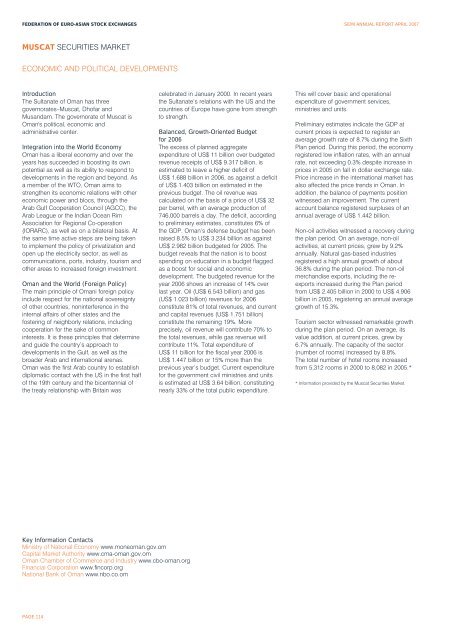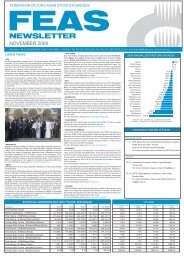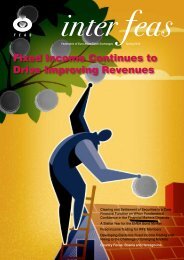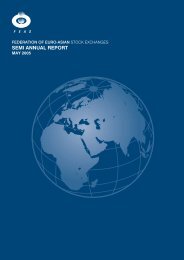Download - FEAS
Download - FEAS
Download - FEAS
Create successful ePaper yourself
Turn your PDF publications into a flip-book with our unique Google optimized e-Paper software.
FEDERATION OF EURO-ASIAN STOCK EXCHANGES SEMI ANNUAL REPORT APRIL 2007<br />
MUSCAT SECURITIES MARKET<br />
ECONOMIC AND POLITICAL DEVELOPMENTS<br />
Introduction<br />
The Sultanate of Oman has three<br />
governorates–Muscat, Dhofar and<br />
Musandam. The governorate of Muscat is<br />
Oman's political, economic and<br />
administrative center.<br />
Integration into the World Economy<br />
Oman has a liberal economy and over the<br />
years has succeeded in boosting its own<br />
potential as well as its ability to respond to<br />
developments in the region and beyond. As<br />
a member of the WTO, Oman aims to<br />
strengthen its economic relations with other<br />
economic power and blocs, through the<br />
Arab Gulf Cooperation Council (AGCC), the<br />
Arab League or the Indian Ocean Rim<br />
Association for Regional Co-operation<br />
(IORARC), as well as on a bilateral basis. At<br />
the same time active steps are being taken<br />
to implement the policy of privatization and<br />
open up the electricity sector, as well as<br />
communications, ports, industry, tourism and<br />
other areas to increased foreign investment.<br />
Oman and the World (Foreign Policy)<br />
The main principle of Omani foreign policy<br />
include respect for the national sovereignty<br />
of other countries, noninterference in the<br />
internal affairs of other states and the<br />
fostering of neighborly relations, including<br />
cooperation for the sake of common<br />
interests. It is these principles that determine<br />
and guide the country’s approach to<br />
developments in the Gulf, as well as the<br />
broader Arab and international arenas.<br />
Oman was the first Arab country to establish<br />
diplomatic contact with the US in the first half<br />
of the 19th century and the bicentennial of<br />
the treaty relationship with Britain was<br />
celebrated in January 2000. In recent years<br />
the Sultanate’s relations with the US and the<br />
countries of Europe have gone from strength<br />
to strength.<br />
Balanced, Growth-Oriented Budget<br />
for 2006<br />
The excess of planned aggregate<br />
expenditure of US$ 11 billion over budgeted<br />
revenue receipts of US$ 9.317 billion, is<br />
estimated to leave a higher deficit of<br />
US$ 1.688 billion in 2006, as against a deficit<br />
of US$ 1.403 billion on estimated in the<br />
previous budget. The oil revenue was<br />
calculated on the basis of a price of US$ 32<br />
per barrel, with an average production of<br />
746,000 barrels a day. The deficit, according<br />
to preliminary estimates, constitutes 6% of<br />
the GDP. Oman’s defense budget has been<br />
raised 8.5% to US$ 3.234 billion as against<br />
US$ 2.982 billion budgeted for 2005. The<br />
budget reveals that the nation is to boost<br />
spending on education in a budget flagged<br />
as a boost for social and economic<br />
development. The budgeted revenue for the<br />
year 2006 shows an increase of 14% over<br />
last year. Oil (US$ 6.543 billion) and gas<br />
(US$ 1.023 billion) revenues for 2006<br />
constitute 81% of total revenues, and current<br />
and capital revenues (US$ 1.751 billion)<br />
constitute the remaining 19%. More<br />
precisely, oil revenue will contribute 70% to<br />
the total revenues, while gas revenue will<br />
contribute 11%. Total expenditure of<br />
US$ 11 billion for the fiscal year 2006 is<br />
US$ 1.447 billion or 15% more than the<br />
previous year’s budget. Current expenditure<br />
for the government civil ministries and units<br />
is estimated at US$ 3.64 billion, constituting<br />
nearly 33% of the total public expenditure.<br />
This will cover basic and operational<br />
expenditure of government services,<br />
ministries and units.<br />
Preliminary estimates indicate the GDP at<br />
current prices is expected to register an<br />
average growth rate of 8.7% during the Sixth<br />
Plan period. During this period, the economy<br />
registered low inflation rates, with an annual<br />
rate, not exceeding 0.3% despite increase in<br />
prices in 2005 on fall in dollar exchange rate.<br />
Price increase in the international market has<br />
also affected the price trends in Oman. In<br />
addition, the balance of payments position<br />
witnessed an improvement. The current<br />
account balance registered surpluses of an<br />
annual average of US$ 1.442 billion.<br />
Non-oil activities witnessed a recovery during<br />
the plan period. On an average, non-oil<br />
activities, at current prices, grew by 9.2%<br />
annually. Natural gas-based industries<br />
registered a high annual growth of about<br />
36.8% during the plan period. The non-oil<br />
merchandise exports, including the reexports<br />
increased during the Plan period<br />
from US$ 2.405 billion in 2000 to US$ 4.906<br />
billion in 2005, registering an annual average<br />
growth of 15.3%.<br />
Tourism sector witnessed remarkable growth<br />
during the plan period. On an average, its<br />
value addition, at current prices, grew by<br />
6.7% annually. The capacity of the sector<br />
(number of rooms) increased by 8.8%.<br />
The total number of hotel rooms increased<br />
from 5,312 rooms in 2000 to 8,082 in 2005.*<br />
* Information provided by the Muscat Securities Market.<br />
Key Information Contacts<br />
Ministry of National Economy www.moneoman.gov.om<br />
Capital Market Authority www.cma-oman.gov.om<br />
Oman Chamber of Commerce and Industry www.cbo-oman.org<br />
Financial Corporation www.fincorp.org<br />
National Bank of Oman www.nbo.co.om<br />
PAGE 114
















